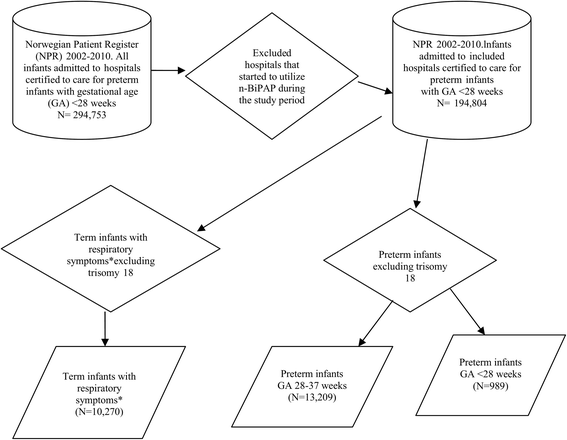Economic and health consequences of non-invasive respiratory support in newborn infants: a difference-in-difference analysis using data from the Norwegian patient registry
- PMID: 25366808
- PMCID: PMC4232673
- DOI: 10.1186/s12913-014-0494-4
Economic and health consequences of non-invasive respiratory support in newborn infants: a difference-in-difference analysis using data from the Norwegian patient registry
Abstract
Background: Newborn infants with respiratory failure are often treated with intubation and mechanical ventilation for prolonged periods of time. Our objective was to evaluate whether increasing use of non-invasive respiratory support in newborn infants can improve patient health and reduce costs.
Methods: We utilized a natural experiment that took place in October 2008 when a large neonatal intensive care unit in Norway moved into a new hospital building with new medical equipment. A change in respiratory support towards increasing use of nasal biphasic positive airway pressure (n-BiPAP) instead of invasive mechanical ventilation treatment followed the acquisition of the new equipment. We used a difference-in-difference method and data from the Norwegian National Patient Registry to assess morbidity, mortality, number of hospital days and hospital costs in our unit following this change. We stratified the results according to gestational age groups.
Results: We found a reduction in morbidity including bronchopulmonary dysplasia, retinopathy of prematurity and intraventricular hemorrhage. No change in mortality was found. We found a reduction in number of hospital days and hospital costs for preterm infants with gestational age <28 weeks and for term infants with diagnoses affecting respiration.
Conclusions: We conclude that increasing use of n-BiPAP may improve health and reduce costs. However, more research is needed to establish best practice. Comparing hospitals where treatment practices change to hospitals where the same change does not occur may be a useful way to evaluate the efficacy of such a change, especially when hospitals can be studied over time.
Figures
Similar articles
-
N-BiPAP treatment in infants with respiratory distress syndrome: A population study.Early Hum Dev. 2015 Oct;91(10):577-81. doi: 10.1016/j.earlhumdev.2015.07.004. Epub 2015 Jul 25. Early Hum Dev. 2015. PMID: 26217937
-
[Application of three kinds of non-invasive positive pressure ventilation as a primary mode of ventilation in premature infants with respiratory distress syndrome: a randomized controlled trial].Zhonghua Er Ke Za Zhi. 2014 Jan;52(1):34-40. Zhonghua Er Ke Za Zhi. 2014. PMID: 24680406 Clinical Trial. Chinese.
-
Less invasive surfactant administration versus endotracheal surfactant instillation followed by limited peak pressure ventilation in preterm infants with respiratory distress syndrome in China: study protocol for a randomized controlled trial.Trials. 2020 Jun 11;21(1):516. doi: 10.1186/s13063-020-04390-3. Trials. 2020. PMID: 32527290 Free PMC article.
-
Bi-Level Noninvasive Ventilation in Neonatal Respiratory Distress Syndrome. A Systematic Review and Meta-Analysis.Neonatology. 2021;118(3):264-273. doi: 10.1159/000514637. Epub 2021 Mar 23. Neonatology. 2021. PMID: 33756488
-
Approaches to Noninvasive Respiratory Support in Preterm Infants: From CPAP to NAVA.Neoreviews. 2019 Apr;20(4):e213-e221. doi: 10.1542/neo.20-4-e213. Neoreviews. 2019. PMID: 31261062 Review.
Cited by
-
Creation of a rating scale to teach Less Invasive Surfactant Administration (LISA) in simulation.BMC Med Educ. 2024 Feb 14;24(1):146. doi: 10.1186/s12909-024-05118-6. BMC Med Educ. 2024. PMID: 38355497 Free PMC article.
-
Improving clinical outcomes of very low birth weight infants: Implementation of standardized management guidelines in tertiary care hospital in Haryana.Int J Pediatr Adolesc Med. 2020 Dec;7(4):174-180. doi: 10.1016/j.ijpam.2019.08.002. Epub 2019 Aug 23. Int J Pediatr Adolesc Med. 2020. PMID: 33319015 Free PMC article.
-
Resource utilization patterns using non-invasive ventilation in neonates with respiratory distress syndrome.J Perinatol. 2018 Jul;38(7):850-856. doi: 10.1038/s41372-018-0122-y. Epub 2018 May 24. J Perinatol. 2018. PMID: 29795324 Free PMC article.
-
Implementation of less invasive surfactant administration in clinical practice-Experience of a mid-sized country.PLoS One. 2020 Jul 6;15(7):e0235363. doi: 10.1371/journal.pone.0235363. eCollection 2020. PLoS One. 2020. PMID: 32628732 Free PMC article.
References
-
- Davis PG, Henderson-Smart DJ: Nasal continuous positive airways pressure immediately after extubation for preventing morbidity in preterm infants.Cochrane Database Syst Rev 2003, (2):CD000143. Review - PubMed
Publication types
MeSH terms
LinkOut - more resources
Full Text Sources
Other Literature Sources


